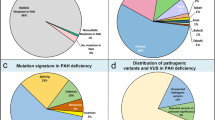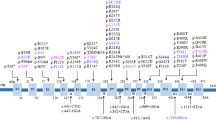Abstract
Newborn screening for PKU has been in practice in Iran since 2007. Some hyperphenylalaninemia cases have tetrahydrobiopterin (BH4) biosynthesis deficiency/disorder. Several genes including QDPR (encodes DHPR enzyme, the necessary cofactor for PAH activity) have been associated with the BH4. Mutations have been previously described in the QDPR gene. The incidence of BH4 deficiency is expected to be higher in Iran due to high rate of consanguineous marriages.
We identified a total of 93 BH4-deficient families. A multiplex set of STR markers linked to 4 genes responsible for the BH4 deficiency (i.e., GCH1, PCBD1, PTS, and QDPR genes) was used to quickly determine which gene may be responsible to cause the disease. Mutation analysis of QDPR gene revealed some known and novel mutations. Our findings show that no common mutation predominates, and they are scattered in the gene in our population.
Competing interests: None declared
Hannaneh Foroozani and Maryam Abiri equally contributed to this work.
Access this chapter
Tax calculation will be finalised at checkout
Purchases are for personal use only
Similar content being viewed by others
References
Adzhubei IA, Schmidt S, Peshkin L et al (2010) A method and server for predicting damaging missense mutations. Nat Methods 7:248–249
Blau N, Thony B, Cotton RG (2001) Disorders of tetrahydrobiopterin and related biogeninc amines. In: Scriver CR, Beaudet A, Sly WS, Valle D, Childs B, Vogelstein B (eds) The metabolic and molecular bases of inherited disease. McGraw Hill, New York, pp 1275–1776
Blau N, Bonafe L, Blaskovics M (2005) Disorders of phenylalanine and tetrahydrobiopterin metabolism. In: Blau N, Duran M, Blaskovics M, Gibson K (eds) Physician’s guide to the laboratory diagnosis of metabolic disease. Chapman & Hall, London, pp 89–106
Blau N, Hennermann JB, Langenbeck U, Lichter-Konecki U (2011) Diagnosis, classification, and genetics of phenylketonuria and tetrahydrobiopterin (BH4) deficiencies. Mol Genet Metab 104:S2–S9
Dianzani I, Howells DW, Ponzone A, Saleeba JA, Smooker PM, Cotton RG (1993) Two new mutations in the dihydropteridine reductase gene in patients with tetrahydrobiopterin deficiency. J Med Genet 30:465–469
Kumar P, Henikoff S, Ng PC (2009) Predicting the effects of coding non-synonymous variants on protein function using the SIFT algorithm. Nat Protoc 4:1073–1081
Miller S, Dykes D, Polesky H (1988) A simple salting out procedure for extracting DNA from human nucleated cells. Nucleic Acids Res 16:1215
Najmabadi H, Neishabury M, Sahebjam F et al (2003) The Iranian Human Mutation Gene Bank: a data and sample resource for worldwide collaborative genetics research. Hum Mutat 21:146–150
Romstad A, Kalkanoglu HS, Coskun T et al (2000) Molecular analysis of 16 Turkish families with DHPR deficiency using denaturing gradient gel electrophoresis (DGGE). Hum Genet 107:546–553
Scrutton NS, Berry A, Perham RN (1990) Redesign of the coenzyme specificity of a dehydrogenase by protein engineering. Nature 343:38–43
Setoodeh A, Yarali B, Rabbani A et al (2015) Tetrahydrobiopterin responsiveness in a series of 53 cases of phenylketonuria and hyperphenylalaninemia in Iran. Mol Genet Metab Rep 2:77–79
Smith I, Brenton D (1996) Hyperphenylalaninemias. In: Fernandes J, Saudubray J, van den Berghe G (eds) Inborn metabolic diseases: diagnosis and treatment. Springer-Verlag, Berlin, pp 147–160
Smooker PM, Cotton RG (1995) Molecular basis of dihydropteridine reductase deficiency. Hum Mutat 5:279–284
Smooker PM, Howells DW, Cotton RG (1993) Identification and in vitro expression of mutations causing dihydropteridine reductase deficiency. Biochemistry 32:6443–6449
Venselaar H, te Beek TA, Kuipers RK, Hekkelman ML, Vriend G (2010) Protein structure analysis of mutations causing inheritable diseases. An e-science approach with life scientist friendly interfaces. BMC Bioinformatics 11:548
Wang L, Yu W-M, He C et al (2006) Long-term outcome and neuroradiological findings of31 patients with 6-pyruvoyltetrahydropterin synthase deficiency. J Inherit Metab Dis 29:127–134
Wang W, Gao J, Wang J, Liu C, Meng Y (2012) Cloning, expression and enzymatic properties analysis of dihydrofolate reductase gene from the silkworm, Bombyx mori. Mol Biol Rep 39:10285–10291
Author information
Authors and Affiliations
Corresponding author
Editor information
Editors and Affiliations
Additional information
Communicated by: Nenad Blau, PhD
Appendices
Take-Home Message of the Article
QDPR accounts for the majority of BH4 deficiency with a variety of mutations in Iran.
Compliance with Ethics Guidelines
Hannaneh Foroozani, Maryam Abiri, Shadab Salehpour, Hamideh Bagherian, Zohreh Sharifi, Mohammad Reza Alaei, Shohreh Khatami, Azadmeh S, Aria Setoodeh, Leyli Rejali, Farzaneh Rohani, and Sirous Zeinali declare that they have no conflict of interest.
Contribution of Authors in Project
Maryam Abiri: Interpretation of data and drafting of manuscript
Hannaneh Foroozani: Data collection and doing molecular genetic testing in laboratory
Shadab Salehpour: Clinical diagnosis of patients and responding for clinical comments of the reviewers
Hamideh Bagherian: Genetic counselor of medical genetics laboratory of Kawsar Human Genetics Research Center
Zohreh Sharifi: Primer designing
Shohreh Khatami: Performing biochemical tests for patients and analysis of data
Mohammad Reza Alaei, Aria Setoodeh, Farzaneh Rohani: Clinical diagnosis of patients
Leyli Rejali: Sequencing of pcr product
Sara Azadmehr: Doing molecular genetic testing in laboratory
Sirous Zeinali: Supervisor of the project and edit of manuscript
Rights and permissions
Copyright information
© 2015 SSIEM and Springer-Verlag Berlin Heidelberg
About this chapter
Cite this chapter
Foroozani, H. et al. (2015). Molecular Characterization of QDPR Gene in Iranian Families with BH4 Deficiency: Reporting Novel and Recurrent Mutations. In: Zschocke, J., Baumgartner, M., Morava, E., Patterson, M., Rahman, S., Peters, V. (eds) JIMD Reports, Volume 21. JIMD Reports, vol 21. Springer, Berlin, Heidelberg. https://doi.org/10.1007/8904_2015_441
Download citation
DOI: https://doi.org/10.1007/8904_2015_441
Received:
Revised:
Accepted:
Published:
Publisher Name: Springer, Berlin, Heidelberg
Print ISBN: 978-3-662-47171-5
Online ISBN: 978-3-662-47172-2
eBook Packages: MedicineMedicine (R0)




